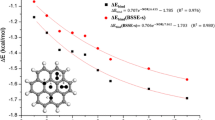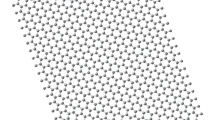Abstract
Studies of the interaction between phenol and intrinsic graphene, as well as phenol and aluminum doped graphene layer are performed using first principles total energy calculations within the periodic density functional theory. A 4x4 periodic structure is used to explore the adsorption of a phenol molecule on the intrinsic graphene and on aluminum doped graphene layer. The electron-ion interactions are modeled using ultra-soft pseudo-potentials, and the exchange-correlation energies are treated according to the generalized gradient approximation (GGA) with the PBE parameterization. We consider different molecule orientations: parallel and perpendicular to the graphene layer to relax the atomic structure. To explain the optimized atomic geometry we determine binding energies for all cases and the density of states (DOS) and partial DOS for the most relevant configurations. Results indicate that the direct interaction of oxygen with aluminum yields the ground state geometry with the phenol molecule adsorbed on the graphene layer. Binding energies and DOS structures also demonstrate that the ground state configuration is that where the O and Al atoms interact with a separation distance of 1.97 Å.
















Similar content being viewed by others
References
Geim AK, Novoselov KS (2007) Nature Materials 6:183–191
Ihn T, Güttinger J, Molitor F, Schnez S, Schurtenberger E, Jacobsen A, Hellmüller S, Frey T, Dröscher S, Stampfer C, Ensslin K (2010) Materials Today 13:44–50
Leenaerts O, Partoens B, Peeters FM (2008) Phys Rev B 77(125416):1–6
Sutter P (2009) Nat Mat 8:171–172
Young JA (2007) J Chem Educ 84:759
Fraser CA (1921) J Phys Chem 25:1–9
Tripathi DG (printed and published) (2008) In: Roy A (ed for and on behalf of Tulip Diagnostics(P) Ltd) J Hyg Sci I(IV):1–16
Tilley FW, Schaffer JM (1926) J Bacteriol 12:303–309
McDonnell G (1999) Denver Russell A. Clin Microbiol Rev 12:147–179
Kim KS, Choi SJ, Ihm SK (1983) Ind Eng Chem Fundam 22:167–172
Hamaidi-Maouche N, Bourouina-Bacha S, Oughlis-Hammache FJ (2009) J Chem Eng Data 54:2874–2880
Zuo X, Peng C, Huang Q, Song S, Wang L, Li D, Fan C (2009) Nano Res 2:617–623
Seredych M, Bandosz TJ (2009) Mat Chem and Phys 113:946–952
Seredych M, Bandosz TJ (2011) Chem Eng J 166:1032–1038
Chi M, Zhao YP (2009) Comp Mat Sci 46:1085–1090
Chakarova-Käck SD, Borck Ø, Schröder E, Lundqvist BI (2006) Phys Rev B 74(155402):1–7
Ao ZM, Yang J, Li S, Jiang Q (2008) Chem Phys Lett 461:276–279
Baroni S, Dal Corso A, de Gironcoli S, Giannozzi P, Cavazzoni C, Ballabio G, Scandolo, S, Chiarotti G, Focher P, Pasquarello A et al (http://www.pwscf.org)
Perdew JP, Burke K, Ernzerhof M (1996) Phys Rev Lett 77:3865–3868
Sholl DS, Steckel JA (2009) Density Functional Theory, A Practical Introduction, 1st edn. Wiley, New York, p 56
Mao Y, Yuan J, Zhong J (2008) J Phys Condens Mater 20(115209):1–6
Galicia-Hernández JM, Hernández-Cocoletzi G, Chigo-Anota E (2011) J Mol Model. doi:10.1007/s00894-011-1046-z
Leenaerts O, Partoens B, Peeters FM (2009) Phys Rev B 79(235440):1–5
Acknowledgments
This work was partially supported by projects: Vicerrectoría de Investigación y Estudios de Posgrado - Benemérita Universidad Autónoma de Puebla (CHAE-ING12-G, EXC11-G), Cuerpo Académico Ingeniería en Materiales (BUAP-CA-177), Cuerpo Académico Física Computacional de la Materia Condensada (BUAP-CA-194) and. The work of G.H.C. was partially supported by Consejo Nacional de Ciencia y Tecnología (83982).
The authors would like to acknowledge the National Supercomputer Center (CNS) of Instituto Potosino de Investigación Científica y Tecnológica, Asociación Civil (IPICyT, A. C.) for supercomputer facilities. Calculations have been also performed at the Computer Center of the Instituto de Física “Ing. Luis Rivera Terrazas” – Benemérita Universidad Autónoma de Puebla.
Author information
Authors and Affiliations
Corresponding author
Rights and permissions
About this article
Cite this article
Hernández, J.M.G., Anota, E.C., de la Cruz, M.T.R. et al. First principles studies of the graphene-phenol interactions. J Mol Model 18, 3857–3866 (2012). https://doi.org/10.1007/s00894-012-1382-7
Received:
Accepted:
Published:
Issue Date:
DOI: https://doi.org/10.1007/s00894-012-1382-7




